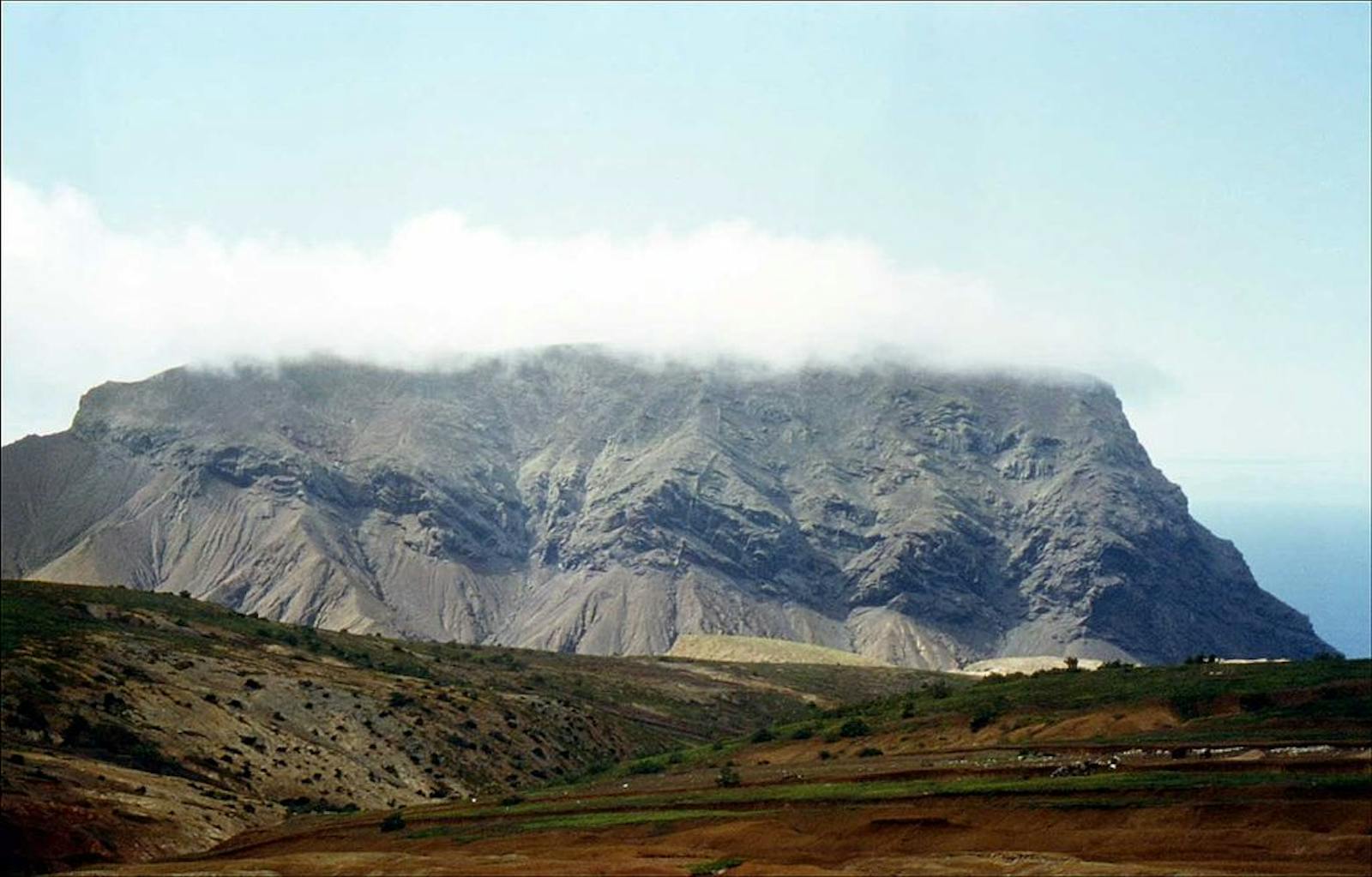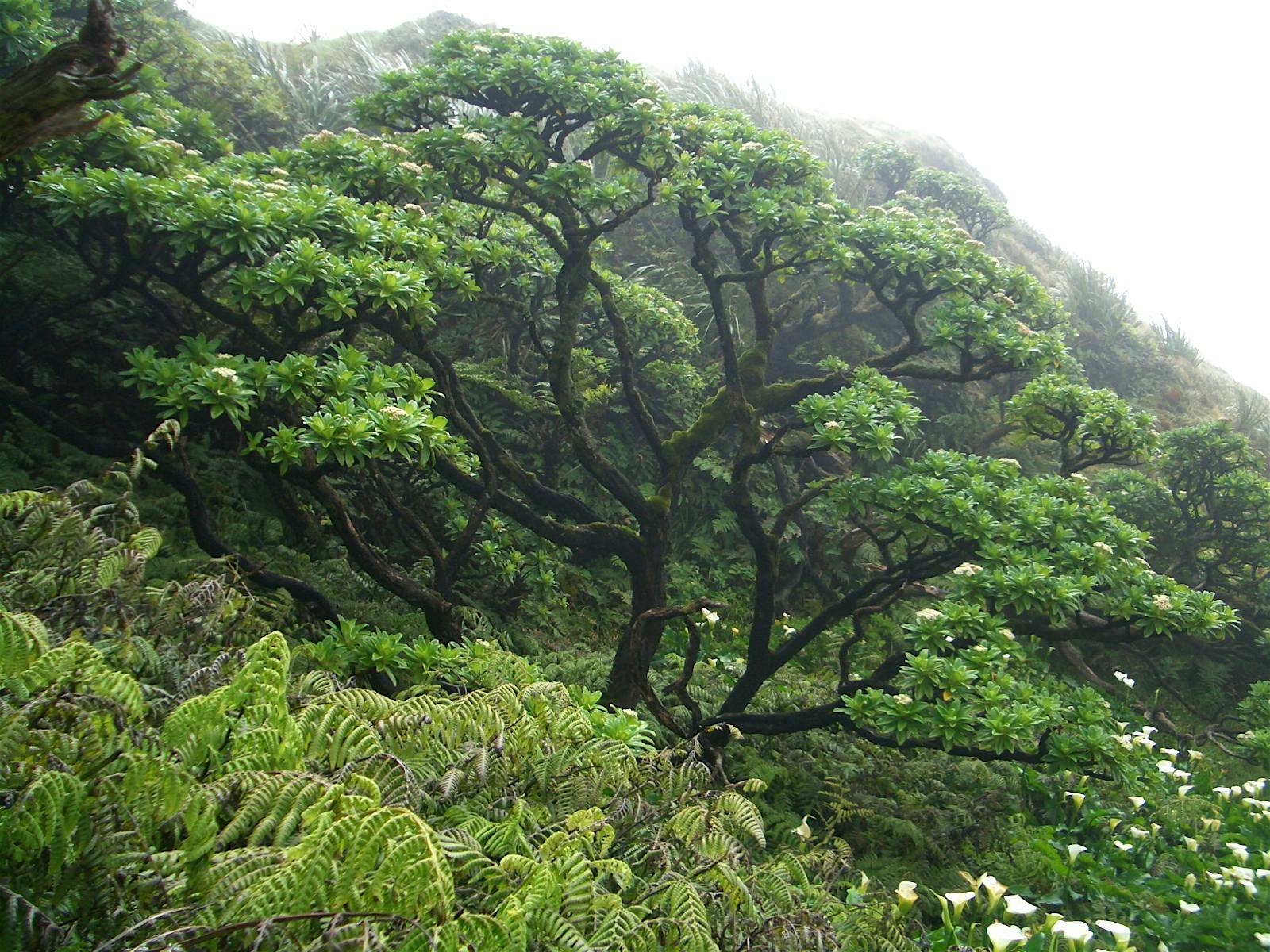St. Helena Scrub and Woodlands
The ecoregion’s land area is provided in units of 1,000 hectares. The protection goal is the Global Safety Net (GSN1) area for the given ecoregion. The protection level indicates the percentage of the GSN goal that is currently protected on a scale of 0-10.
Bioregion: St. Helena & Ascension Islands (AT18)
Realm: Afrotropics
Subrealm: Sub-Equatorial Afrotropics
Ecoregion Size (1000 ha):
13
Ecoregion ID:
60
Conservation Target:
100%
Protection Level:
4
States: British Overseas Territory
Human exploitation of St. Helena Island’s natural resources for over 450 years led to the degradation and erosion of large areas of land, which are now called the "Crown Wastes". This is considered to be one of the first documented environmental disasters instigated by humans. In the early 1900s, St. Helena’s economy became almost totally dependent on New Zealand flax, which is used to make rope and string.
By the time the demand for the crop disappeared in 1966, flax had been planted over much of the island. Despite efforts to clear the plant and restore native vegetation on the island, flax still covers some interior areas of St. Helena and is putting unique flora at extinction risk.
%20is%20the%20flagship%20species%20of%20the%20St.%20Helena%20Scrub%20and%20Woodlands%20ecoregion.%20Image%20credit%20Agami%20Photo%20Agency%20%7C%20Dreamstimne.jpg)
The St. Helena plover (Charadrius sanctaehelenae) is the flagship species of the St. Helena Scrub and Woodlands ecoregion. Image credit: © Agami Photo Agency | Dreamstime
St. Helena Island is in the South Atlantic Ocean, 1,950 km west of the African Coast. About 14 million years old, St. Helena is the deeply eroded summit of a composite volcano. Plugs, domes, and dykes from the volcanoes create striking formations with names such as Lot, Lot's Wife, and the Gates of Chaos. The island covers 122 km2, with coastal cliffs of 300 m, cut by a few steep-sided valleys. The high point of the island, Diana’s Peak, reaches 823 m. The climate is dry subtropical, 15–32°C, with an annual mean rainfall of 152 mm. St. Helena is a British colony, with its capital and port at Jamestown.
As one of the most remote islands in the world, St. Helena is of global importance for its unique biodiversity. Several million years of evolution following natural colonization from the African mainland allowed the development of a rich and unique Indigenous flora with many endemic species. It is believed that many of the island’s native plants are relicts of a primitive flora that was once widespread and that colonized the island as many as 10 million years ago.
An example is the Saint Helena tree fern, Dicksonia arborescens, which has been on the island for at least 9 million years but no longer occurs in its likely source area of Africa. A total of 431 higher plant species are found on the island, 45 of which are endemic. Several of these endemics are thought to be extinct - including the wild olive, cluster-leaved gumwood, and large kidney fern which were last recorded in 2000 and St Helena buck’s-horn, last recorded in 2005. However, one species thought to be extinct has been rediscovered – the tiny annual Bulbostylis neglecta.
Other endemic plants also include the notable cabbage tree or, "insular arborescent Asteraceae", members of the daisy family which have evolved a shrubby or tree-like habit on islands, as well as the closely related St Helena redwood (Trochetiopsis erythroxylon) and St Helena dwarf ebony (Trochetiopsis ebenus). Native birds have fared particularly poorly. Seven out of the eight original endemic birds are now extinct.
At present, the only endemic bird remaining is the St. Helena plover or wirebird, which is restricted to northern flatter portions of the island’s interior. The invertebrate fauna of St. Helena has undergone some repetitive speciation and adaptive radiation, resulting in many endemic species. There are 157 endemic beetles recorded, including a ground beetle (Aplothorax burchelli).
Fragmentation and loss of St. Helena’s natural vegetation began before the island was settled. The majority of the original vegetation has been destroyed, and over half of the island is covered by wastelands of bare soil and sparse, mostly exotic scrub. Less than one percent of the island retains native semi-natural forest in isolated remnants. Some progress has been made in restoration of habitat in the last decades, and the island government has established an "Endemic Section" and a few conservation areas.
St. Helena continues to be threatened by introduced species and exploitation by humans. Water is a scarce resource on St. Helena for humans and nature alike, and drought poses a significant threat to the fragile and isolated ecosystem. There has been a push to promote tourism as a source of revenue, though the island has never been accessible by airplane due to its mountainous terrain. An airport has now been built and the first flight landed in 2017. It is built on land used by the island’s only endemic bird, the St. Helena plover as well as many endemic invertebrates.
Other upgrades following the airport have included new roads to the airports and the expansion of the electricity generating capacity through renewable energy projects including wind turbines and solar farms. The new Wirebirds Hills Hotel and golf course are built on one of the five most important breeding sites for the wirebirds in the world. The wirebird nests on flat areas which is likely to coincide with future development on the island.
Most habitats on the island are under threat from encroachment by invasive species including lantana, fleabane, wild mango, wild coffee, creeper, Bermudan cedar, blueweed, and Cape grass. As well as directly encroaching on native flora, invasive species affect soil erosion, nutrient availability, water availability, as well as the amount of food available for insect pollinators.
Priority conservation actions for the next decade:
- Eradicate invasive species and ensure that a range of suitable native species, preferable endemic, are in sufficient supply in nursery stock for rehabilitation immediately after removal to prevent erosion and invasion by other species such as whiteweed.
- Control and monitor sources for invasive species introduction by improving the capacity of the Jamestown dock to intercept foreign material.
- Establish protected areas on the island, with priority for the remaining habitats of endemic species including the St Helena plover.
-
-
1. WWF. 2018. South Atlantic Ocean. [Online]. [Accessed 17 April 2018]. Available from: https://www.worldwildlife.org/ecoregions/at0720
2. Lambdon, P. and Darlow, A. 2008. Botanical Survey of Ascension Island and St. Helena: A report on the current state of plant invasions, and their implications for conservation and management. [Online]. [Accessed 8 May 2018]. Available from: http://citeseerx.ist.psu.edu/viewdoc/download?doi=10.1.1.739.1494&rep=rep1&type=pdf
3. Clubbe, C., Hamilton, M. and Corcoran, M. 2010. The role of native species nurseries in mitigating threats from invasive species: case studies from UK Overseas Territories. In Proceedings of the 4th Global Botanic Gardens Congress. pp. 1-13.
4. RSPB. 2018. Saint Helena. [Online]. [Accessed 8 May 2018]. Available from: https://www.rspb.org.uk/our-work/our-positions-and-casework/casework/cases/saint-helena/ -
Cite this page: St. Helena Scrub and Woodlands. Ecoregion Snapshots: Descriptive Abstracts of the Terrestrial Ecoregions of the World, 2021. Developed by One Earth and RESOLVE. https://www.oneearth.org/ecoregions/st-helena-scrub-and-woodlands/
-





